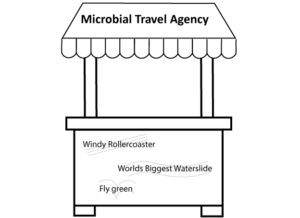Global Antibiotic Resistance: Insights from the Cryosphere


Today’s world faces several major challenges, and let’s be honest – we haven’t been particularly good at addressing them so far. Climate protection is progressing sluggishly, economic challenges affect almost every country, and supply chains still resemble shaky dominoes rather than a solid foundation.


On the health front, the population battled through a global viral pandemic while another one has been quietly advancing for years: antibiotic-resistant bacteria. Dubbed one of the greatest global challenges by the WHO, antibiotic resistance is no longer just a relevant issue in direct human environments. Did you know that there are bacteria on the highest mountains and in the northernmost and southernmost regions of our planet that our antibiotics can’t touch? No? Then let’s find out why together.
Our highly interconnected world today brings many advantages, but this strong interconnectedness also means that virtually everything can spread much faster than before. Microorganisms know no borders, and through us humans, viruses, bacteria, and the like spread lightning-fast, as the COVID-19 pandemic impressively demonstrated. The same goes for antibiotic-resistant bacteria, which can travel around the world on and inside us.

The transport of such organisms in itself might not be the big problem. The real issue is that these bacteria are incredibly good at flaunting their abilities and teaching other bacteria how to neutralize antibiotics. To make matters worse, these microbes are, of course, invisible to the naked eye, and we don’t even realize when we are transporting resistant organisms or when they exchange information… likely a curse and a blessing.
Besides human transport, several other important factors contribute to the spread of microorganisms and potentially antibiotic-resistant bacteria. Global wind systems span the entire globe and sometimes transport entire communities of microorganisms (like with Saharan dust!) from A to B. The same goes for ocean currents and waterways, where antibiotic-resistant bacteria like to drift. For example, resistant microbes from our gut can end up in waterways through sewage and maybe even reach the sea. And as always, these bacteria can potentially teach other bacteria how to become antibiotic-resistant.
When we shift our focus from physical to biological transport routes, migratory birds immediately come to mind. These and other migrating animals can transport bacterial colonies and potentially existing antibiotic resistance genes over thousands of kilometers during their journeys.


By now, we know that all these processes have led to the spread of antibiotic-resistant bacteria across the entire globe. And when I say entire, I mean it. This includes the cryosphere – the region of the Earth where water exists in its solid form as snow (even seasonally) or ice. The highest mountains with their glaciers and even the northernmost and southernmost icy areas of our planet are not free from bacteria that antibiotics cannot affect. Resistances against antibacterial substances of all classes, mechanisms, and manufacturing methods have already been found. The described transport routes certainly play a significant role, especially for antibiotics that have no natural counterparts but are designed and manufactured in the lab. Another factor is likely intrinsic resistances: non-specific defense mechanisms that some bacteria naturally have against harmful substances of all kinds.
Die beschriebenen Transportwege spielen dabei sicher eine wesentliche Rolle, vor allem für Antibiotika, die keine natürlichen Vorbilder haben, sondern im Labor designt und hergestellt werden. Ein weiterer Faktor sind jedoch vermutlich auch sogenannte intrinsische Resistenzen: unspezifische Abwehrmechanismen, die manche Bakterien von Natur aus gegen schädliche Substanzen aller Art schützen.

But why is it relevant to us whether bacteria live in the frozen regions of our planet that are resistant to antibiotics? We likely don’t need to worry about released killer bacteria, as most organisms can’t even survive at 37°C (our body temperature). However, melting processes, which have increased significantly due to climate change, can lead to these resistant bacteria reaching other regions. Glacier meltwater eventually ends up in human settlements, carrying with it these partially multi-resistant organisms. These, in turn, can share their genes with local bacteria, effectively spreading antibiotic resistance. Ultimately, this transmission can also reach pathogens, and that’s definitely something we want to avoid.
The potential of antibiotic-resistant bacteria “washed ashore” by melting processes is still barely understood, but it could play a crucial role in our understanding of the spread and containment of antibiotic resistance. It is, after all, a global phenomenon and should be treated as such because medical facilities are no more closed systems than glaciers, the Arctic, and Antarctica are free from human influence.

